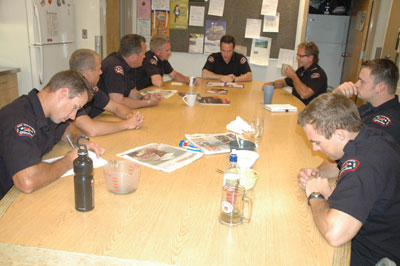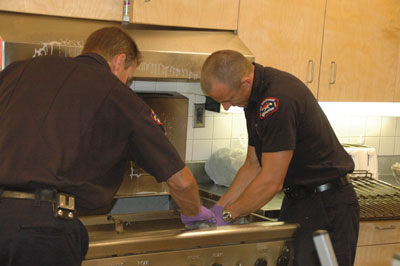
News
The rise and fall of the paramilitary structure
CURRENT ISSUE
The rise and fall of the paramilitary structure
Has your fire department’s tolerance for discipline and traditional top-down rule changed in the last 10 years?
September 28, 2011
By Jay Shaw
Has your fire department’s tolerance for discipline and traditional top-down rule changed in the last 10 years? Is the Canadian fire service following the private-sector trend toward soft-skill human resource policies that are designed to increase efficiency and productivity by coddling employees and nurturing their every need and want?
 |
|
| The paramilitary structure that is the foundation of the North American fire service is built on the tenets of seniority, experience and respect. Some say younger generations of firefighters are losing interest in the top-down formula.
|
Trends such as appreciative inquiry – a positivist’s look at problem solving, or, in other words, looking at what is being done well and ignoring the problem – and other socially responsible organizational behaviour models are prevalent. Businesses are more flexible and reward employees for creative thinking. Work from home? No problem. Need to leave early? Sure. Yoga classes at lunch? You got it. Free high-end coffee and pet sitting? If it makes workers feel more valued, companies will do it.
All of which is well and good in today’s busy and evolving work world and, perhaps, a necessary evil if employers want to get the most from workers. But can a fire service move away from its paramilitary roots to properly and safely serve its customers and protect its own?
There’s was story making the rounds early this year about a young member who walked into a holiday gathering of fellow firefighters. He called out to a retired captain, whom he obviously still held in high regard, and said, “Cap, how are you sir?” A current captain, within earshot, heard the complimentary quip, and, tongue-in-cheek, bellowed out, “You don’t get that kind of respect any more in the halls. I feel like I’m babysitting sometimes. I actually had to tell our rookie to put his freaking phone away. He looked at me square in the eyes and said, ‘Why?’ ”
This exchange, of course, opened a Pandora’s box of all things from the old days, as a few junior members listened to stories for half an hour about how the job has changed and how the new kids (meaning those with fewer years of service than the person telling the story) just don’t get it anymore.
Behaviourists say these workplace changes are a result of technological advances and societal demands. We are in a rush all the time. We need instant access to information. We demand better services and benefits. We want luxury working conditions. And yet, we offer nothing in return to our employers for these creature comforts. Employees of the Canadian fire service are part of the same demographic as the rest of the national work force, and this means that we, too, are subject to these types of cultural shifts. Our young workers come from the same cultural backgrounds as those in every other industry experiencing problems with a workforce infatuated with instant gratification.
Retired Dalhousie University sociology professor Dr. John Benoit, who has spent much of his career researching the fire service, agrees that there has been a change in attitudes and values.
“It is apparent that these observed generational behaviour trends are affecting the Canadian workforce and businesses,” he says. “The question is, how does this correlate to the fire service? We need to do some research here to further examine this hypothesis, because we need answers before the rudder comes off.”
Recently retired Vancouver Fire and Rescue Services Battalion Chief Wayne Humphry, who served for more than 32 years, is the owner and chief consultant for Fire Works Consulting and Training Services (www.fireworksconsulting.ca ), and has seen in action this move away from the paramilitary structure.
“A large portion of this has to do with the hiring practices and the HR involvement that didn’t exist years ago,” he said. “And tie this to the fact that most organizations only hire those candidates that have the required training, which means you can only select from those that can afford to take time away from work and afford this type of training . . . it drastically reduces the number of candidates to choose from and the result is they have less loyalty to the organization.”
Vancouver Battalion Chief Randy Hebenton offers insight about this shift in employee behaviour.
“We came on under the watchful eye of the ’46ers – post-war era, hard-nosed old vets who were big on, and instilled, the military values, which the fire departments follow in many ways,” he says.
“I believe the younger generation of firefighters has a heightened view of the world and what they want, but not enough life experience to see that they have to wait a while to use their knowledge.”
Hebenton believes new firefighters – through no fault of their own – are less informed about fire-service traditions and values, partly because departments have moved away from training their own. This change, he says, has led to a lack of respect for those traditions and values.
 |
|
| In many fire departments, station duties are based on seniority. Photo by Laura King |
“Some new rookies also have a tendency for instant gratification,” he adds. “They want things now, not later, and don’t seem as prepared to work for it, to earn it, and to establish their place in the organization and culture by putting in their time, getting the required experience and earning the respect of the others that have moved through the organization in this manner.”
The term paramilitary, or semi-military, means a group or agency of individuals acting under the resemblance of a true military system, such as the Canadian Forces. The term paramilitary is subjective, and can mean different things in different countries. In North America, law-enforcement agencies, fire departments, coast guard, cadet organizations and security companies are examples of paramilitary structures.
Peter Sells, a retired Toronto Fire Services district chief, offers some perspective on the paramilitary structure and a good example of how it taught him to respect his superiors.
“When I joined the Toronto Fire Department in 1986 as a fresh college kid with no fire background, I expected a paramilitary environment and that’s exactly what I got,” Sells says. “It was clear that I was low man on the totem pole and I understood and accepted that. My opinions on fire fighting were given no regard, and although I felt that I did have some knowledge and insight to contribute, again I accepted my place.”
Sells remembers that dominoes was the game of choice for most of the veteran guys and when the dominoes came out, he was ordered out of the room.
“I thought this was petty and stupid, but it’s not like I really wanted to watch four guys play dominoes, and the hall was plenty big enough to find someplace else to hang out if the evening was slow.
Then, he says, came his big break.
“One night, the other truck was out of the hall for a couple of hours and the old guys needed a fourth for dominoes. The same senior man who forbade me from playing was now inviting me in. I told him to shove the dominoes up his ass; I was playing darts by myself. Thirty minutes later, after a whole lot of grumbling which I overheard from the next room, and thoroughly enjoyed, the three of them announced that we were playing darts and told me who I was paired with. That senior man made my life hell for my first four years on the job. He had a long-standing reputation as a grumpy old man and it was well known that I was his latest whipping boy. Still, of all of the department funerals I have attended in the last 25 years, his is one that sticks out in my mind. I learned a lot from him.”
No one is saying that we need to go back to times when disrespect and outright rude behaviour was more the norm. Yet municipal governments need to be mindful of policies that conflict with fire-department guidelines and operational procedures, particularly those that use a hierarchical system of structure and discipline. Fire departments aren’t renewing pet licences or running community clubs; firefighters are risking their lives to save life and property. The practice of discipline is key to making sure order is maintained when and where it is needed most – on the fire ground. Discipline in the station means a higher likelihood of compliance when it’s really needed.
It’s clear from reading newspapers or listening to workplace experts that the erosion of traditional work ethic and values is not a regional quandary, but a national epidemic. From coast to coast, in all employment sectors of Canada, people have noticed a generational change in the young worker. There must be a problem when today’s 20-somethings have been coined “generation Y-Not” and “generation Me.”
University of Manitoba sociologist Dr. Lori Wilkinson says the problem – like so many societal issues – starts at home.
“Many social sciences trace the change in work to the values instilled by parents in their children in recent years,” she says.
“Children are increasingly socialized to be independent at a young age. This causes difficulties at home, as youth question their parents’ authority. This culture of independence doesn’t lend itself very well to workplaces that value working together for a common good or purpose, much like what you might find in the police force, in a hospital setting and in the fire-protection services.”
The fire service needs to do a better job educating fire administrators and floor officers about ways to bridge the gap between old-school, tried-and-true methods of managing and new techniques that value the education and energy that new recruits bring to the table.
Sells offers some solutions that can be effective – but only if they’re implemented.
“We need to establish, or re-establish, some rules of behaviour and then enforce them,” he says. “The days of the pecking order are over, but young folks still expect direction from their superiors.
“In my opinion, the last wave of deterioration of discipline in the fire service has not been due to the gen-Y rookies, but due to the gen-X captains not enforcing the same levels of discipline that they were subject to 15 or 20 years previous. Have rules that are sensible, legal and reasonable. Make sure they are communicated to all members and then hold people accountable.”
There are all kinds of famous quotes that don’t need to be repeated here about what happens in the absence of leadership and structure. But while the fire service is embracing change and empowering leaders to move us through the 21st century, we need to look to the past and remember how we got here in the first place. Maybe it’s time for a history lesson.
Jay Shaw is a nine-year member of the Winnipeg Fire Department. Shaw has worked in hospital emergency rooms, rural ambulance services and with the Canadian Forces fire service. He is completing graduate studies in Disaster and Emergency Management at Royal Roads University. Contact him at jayshaw@mts.net
Print this page